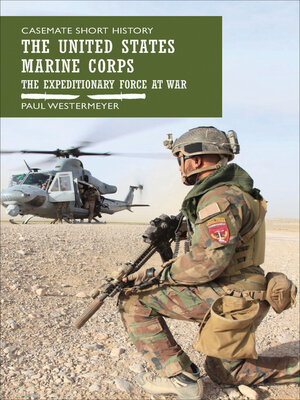The United States Marine Corps
ebook ∣ The Expeditionary Force at War · Casemate Short History
By Paul Westermeyer

Sign up to save your library
With an OverDrive account, you can save your favorite libraries for at-a-glance information about availability. Find out more about OverDrive accounts.
Find this title in Libby, the library reading app by OverDrive.



Search for a digital library with this title
Title found at these libraries:
| Library Name | Distance |
|---|---|
| Loading... |
A concise overview of USMC history from an award-winning author, including photos and a timeline: “Educational and enjoyable.” —Booklist
Many think of the United States Marine Corps as a second land army, and while it has been employed in that capacity, it is foremost a naval expeditionary force able to seize, secure, and defend advanced naval bases in support of major campaigns.
The Corps dates back to the Revolutionary War, but while they served in the conflicts of the nineteenth century, they are famed for their part in the wars of the twentieth century. On the Western Front in World War I they were blooded at Belleau Wood. Between the wars the Corps developed amphibious tactics that were employed to great effect during the Pacific island campaigns during World War II, including the infamous battles of Peleliu, Iwo Jima, and Okinawa. The name of the Corps is forever entwined with the battles of Inchon and Chosin Reservoir in Korea, and Hue and Khe Sanh in Vietnam. The US Marines have continued their expeditionary role to this day, undertaking not only combat operations but also peacekeeping, peace enforcement, humanitarian relief, and short-notification/limited-duration contingency operations. This short history charts the evolution of the Corps as it has adapted to changing combat over two centuries.
Many think of the United States Marine Corps as a second land army, and while it has been employed in that capacity, it is foremost a naval expeditionary force able to seize, secure, and defend advanced naval bases in support of major campaigns.
The Corps dates back to the Revolutionary War, but while they served in the conflicts of the nineteenth century, they are famed for their part in the wars of the twentieth century. On the Western Front in World War I they were blooded at Belleau Wood. Between the wars the Corps developed amphibious tactics that were employed to great effect during the Pacific island campaigns during World War II, including the infamous battles of Peleliu, Iwo Jima, and Okinawa. The name of the Corps is forever entwined with the battles of Inchon and Chosin Reservoir in Korea, and Hue and Khe Sanh in Vietnam. The US Marines have continued their expeditionary role to this day, undertaking not only combat operations but also peacekeeping, peace enforcement, humanitarian relief, and short-notification/limited-duration contingency operations. This short history charts the evolution of the Corps as it has adapted to changing combat over two centuries.







